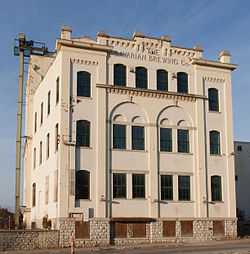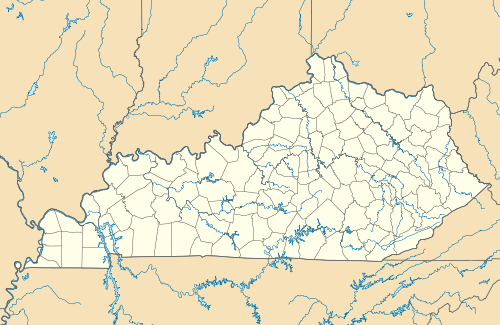Bavarian Brewing Company
 | |
| Private | |
| Industry | Beverages |
| Founded | 1866 |
| Founder | Julius Deglow |
| Defunct | 1966 |
| Headquarters | Covington, Kentucky, United States |
Key people | William Riedlen; Lucia Riedlin Schott, William C. Schott, George Schott, Louis Schott, William R. Schott and Louis L. Schott |
| Products | Beers, ales, malt liquors, soft drinks and ice. |
|
Bavarian Brewing Company | |
 | |
 | |
| Location | 522 W. 12th St. Covington, Kentucky |
|---|---|
| Coordinates | 39°4′38″N 84°31′5″W / 39.07722°N 84.51806°WCoordinates: 39°4′38″N 84°31′5″W / 39.07722°N 84.51806°W |
| Architect | Unknown |
| Architectural style | Romanesque |
| NRHP Reference # | 96000281[1] |
| Added to NRHP | March 21, 1996 |
Bavarian Brewing Company was a brewery established in Covington, Kentucky, in 1866 by Julius Deglow as the Deglow & Company Brewery, but became known as the Bavarian Brewery as early as 1869. The brewery was originally located on Pike Street and the business expanded to include the 12th street property by 1877. The company merged with International Breweries, Inc., in 1959 and operated as Bavarian Division, International Breweries, Inc. The facility closed in 1966. However, it was rehabilitated and placed on the National Register of Historic Places in the late 1990s.[2]
Early history
Ownership of the brewery changed several times in the 1870s, always keeping the Bavarian Brewery name. In 1882, a German immigrant named William Riedlin entered into partnership with John Meyer who purchased the brewery with other partners in 1879. Riedlin acquired the brewery building and a lot with Meyer in 1884. In 1889, Riedlin purchased controlling interest in the brewery from Meyer, incorporated the business as Bavarian Brewing Company and became president. A decade later it became the largest brewery in the state. A number of changes were made to the facility during Riedlin's tenure including the brewery's first bottling plant built in 1892. Key bottling innovations including the crown bottle cap and pasteurization increased the shelf life of beer, enabling it to be distributed to a much wider area. Besides Bavarian Beer, the company also offered Riedlin Select Beer. Annual beer production also increased substantially during this period, from 7,341 barrels in 1870 to 216,000 barrels in 1914.
Operations expanded from the original location on Pike street to include several structures on the property between Pike Street and 12th Street. The brewery also comprised several ice ponds and an ice house that manufactured 200,000 pounds of ice daily. Ice was used in the lager fermentation process before refrigeration became available.[2]
Beer production was halted abruptly with the introduction of Prohibition in 1919, the year of William Riedlin's death. Although the brewery was shut down, the company continued bottling soft drinks under the name The William Riedlin Beverage Company.[2][3]
Post-prohibition
The brewery reopened after the 1933 repeal of Prohibition under the leadership of M. L. Vorhees who had married Riedlin's granddaughter, Rosemary. Besides offering Bavarian Beer, the brewery also offered Cincinnati's Pride Brand Beer to commemorate the 1933 opening of the Cincinnati Union Terminal. The company struggled financially and went into receivership in 1937. Needing additional cash and financing, the brewery and its assets were purchased in 1938 by William C. Schott, the husband of Riedlin's daughter Lucia, and his three brothers, George, Louis and Chris Schott. These brothers also owned the Cincinnati Galvanizing Company, which was formerly the J. M. Schott & Sons Galvanizing Co., founded by their father.[2]
George became the company's President, Wm. C. was Vice President, Louis was Secretary/Treasurer, but Chris resigned within the first year. In 1945, George resigned and Louis Schott became president. Key brand names included: Bavarian's Old Style, Bavarian Master Brand, Bavarian Bock and Schott's Ale. The brewing company thrived under its new management, particularly between 1947 and 1952 when it operated around the clock to meet demand. During these prosperous years the company acquired the Heidelberg Brewery of Covington in 1949 and the Bruckmann Brewery of Cincinnati in 1950. In 1954, the son of Wm. C. Schott, Wm. R. Schott, who had joined the firm in 1945 as Secretary/Treasurer, became President and his former position was replaced by his brother, Louis L. Schott.
By the mid-1950s, Bavarian realized that its dated facilities and operation of two bottling plants were creating higher operating costs than its competitors. As a result, in 1956, Bavarian expanded and modernized its primary plant and sold its smaller Heidelberg plant. However, during this same period the company also began losing market share to larger breweries with a national advertising presence. In particular, Budweiser Inc. introduced Bush Bavarian Beer in 1955, which Bavarian Brewing claimed infringed on its key brand name. In a landmark legal decision in 1957 (Bavarian Brewing Company v. Anheuser-Bush), Budweiser was allowed to use the term Bavarian associated with its Bush beer, but was prevented from selling it in Bavarian Brewing Company's tri-state trading area. Still, economies of scale made it difficult for smaller brewers like Bavarian to compete. Bavarian Brewing merged with International Brewing (IBI) of Detroit in 1959. Brands bottled in the Covington plant during the IBI years included: Bavarian's Select Beer, FrankenMuth Beer/Ale, IBI Malt Liquor, Silver Bar Beer/Ale, Tropical Beer and Phoenix Beer. By the mid-1960s, the Bavarian plant was losing money and the decision was made to close it in 1966. The buildings and equipment were sold at auction by the end of 1966.[4]
The landmark Bavarian Brewery building fell into disrepair over the next three decades. However, its accessibility and visibility from Interstate 75, just a couple exits from downtown Cincinnati, as well as its unique Romanesque and "castle like" architecture, made it an attractive economic development project for the City of Covington. In 1996 the property became listed on the National Register of Historic Places and was rehabilitated. It has been operated as the Party Source, the Brew Works and most recently, Jillian's restaurant and nightclub. Despite the renovation efforts, it is now vacant and for sale. In 2014, the owners of the building announced their intention to tear it down.[5][6]
References
- ↑ "National Register Information System". National Register of Historic Places. National Park Service. 2010-11-27.
- ↑ 2.0 2.1 2.2 2.3 "The Bavarian Brewing Company" (PDF). National Register of Historic Places Registration Form. National Park Service. Retrieved 2010-11-27.
- ↑ "Bavarian Brewing survived Prohibition". Encyclopedia of Northern Kentucky. Kentucky Enquirer. Retrieved 2010-11-27.
- ↑ "Northern Kentucky Post-Prohibition Breweries". Over The Barrel. Sudhaus Press. Retrieved 2013-05-12.
- ↑ "Building's owners propose demolition of Covington's Bavarian Brewery". WLWT-TV. Retrieved 10 November 2014.
- ↑ "Covington's Bavarian Brewery safe for now". Cincinnati.com. Retrieved 18 November 2014.